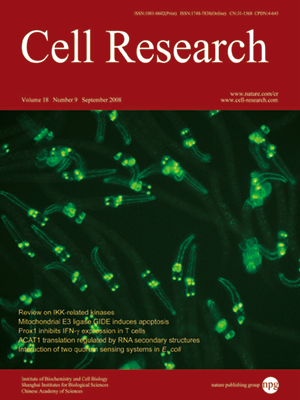
Volume 18, No 9, Sep 2008
ISSN: 1001-0602
EISSN: 1748-7838 2018
impact factor 17.848*
(Clarivate Analytics, 2019)
Volume 18 Issue 9, September 2008: 921-936
ORIGINAL ARTICLES
RNA secondary structures located in the interchromosomal region of human ACAT1 chimeric mRNA are required to produce the 56-kDa isoform
Jia Chen1,*, Xiao-Nan Zhao1,*, Li Yang1, Guang-Jing Hu1, Ming Lu1, Ying Xiong1, Xin-Ying Yang1, Catherine CY Chang2, Bao-Liang Song1, Ta-Yuan Chang2 and Bo-Liang Li1
1State Key Laboratory of Molecular Biology, Institute of Biochemistry and Cell Biology, Shanghai Institutes for Biological Sciences, Chinese Academy of Sciences, 320 Yueyang Road, Shanghai 200031, China
2Department of Biochemistry, Dartmouth Medical School, Hanover, NH 03756, USA
Correspondence: Bo-Liang Li(blli@sibs.ac.cn )
We have previously reported that the human ACAT1 gene produces a chimeric mRNA through the interchromosomal processing of two discontinuous RNAs transcribed from chromosomes 1 and 7. The chimeric mRNA uses AUG
1397-1399 and GGC
1274-1276 as translation initiation codons to produce normal 50-kDa ACAT1 and a novel enzymatically active 56-kDa isoform, respectively, with the latter being authentically present in human cells, including human monocyte-derived macrophages. In this work, we report that RNA secondary structures located in the vicinity of the GGC
1274-1276 codon are required for production of the 56-kDa isoform. The effects of the three predicted stem-loops (nt 1255-1268, 1286-1342 and 1355-1384) were tested individually by transfecting expression plasmids into cells that contained the wild-type, deleted or mutant stem-loop sequences linked to a partial ACAT1 AUG open reading frame (ORF) or to the ORFs of other genes. The expression patterns were monitored by western blot analyses. We found that the upstream stem-loop
1255-1268 from chromosome 7 and downstream stem-loop
1286-1342 from chromosome 1 were needed for production of the 56-kDa isoform, whereas the last stem-loop
1355-1384 from chromosome 1 was dispensable. The results of experiments using both monocistronic and bicistronic vectors with a stable hairpin showed that translation initiation from the GGC
1274-1276 codon was mediated by an internal ribosome entry site (IRES). Further experiments revealed that translation initiation from the GGC
1274-1276 codon requires the upstream AU-constituted RNA secondary structure and the downstream GC-rich structure. This mechanistic work provides further support for the biological significance of the chimeric nature of the human ACAT1 transcript.
Cell Research (2008) 18:921-936. doi: 10.1038/cr.2008.66; published online 10 June 2008
FULL TEXT | PDF
Browse 2065


